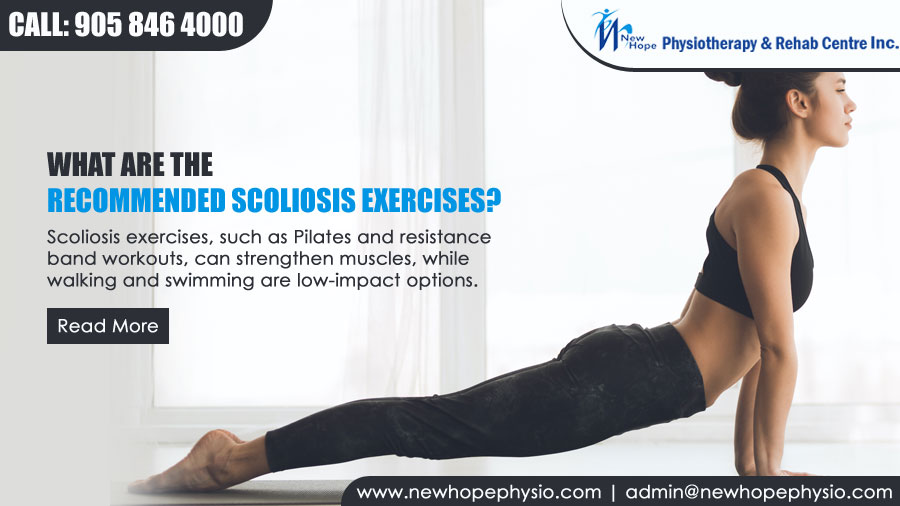
Welcome to New Hope Physiotherapy
- Brampton 905-846-4000
- Malton 905-364-3900
- Orangeville 519-217-9300
- admin@newhopephysio.com
- Home
- Blog
What are the Recommended Scoliosis Exercises?
 17 Apr 2023
17 Apr 2023
- Comments
- 1584
What are the Recommended Scoliosis Exercises?
Scoliosis is a medical condition that affects the spine, causing it to curve sideways. The severity of scoliosis varies, and in many cases, it can be managed through a combination of exercises and other therapies. In this blog, we will discuss some of the recommended exercises for scoliosis.
Also Read: World Mental Health Day 2025 – New Hope Physiotherapy
10 Recommended Scoliosis Exercises
1. Stretching Exercises
Stretching exercises can help to reduce pain and improve flexibility. Here are a few examples:
- Side Stretch: Stand with your feet shoulder-width apart and your arms raised above your head. Lean to the left and hold for 10 seconds before returning to the starting position. Repeat on the right side.
- Cat-Camel Stretch: Get on your hands and knees and arch your back upward like a cat. Then, arch your back downward like a camel. Repeat for 10 repetitions.
- Knee-to-Chest Stretch: Lie on your back with your knees bent and your feet flat on the ground. Bring one knee to your chest and hold for 10 seconds before switching sides.
2. Strengthening Exercises
Strengthening exercises can help to improve posture and reduce the risk of further curvature of the spine. Here are a few examples:
- Plank: Get into a push-up position, but instead of lowering your body to the ground, hold your body in a straight line for as long as you can.
- Superman: Lie face down with your arms stretched out in front of you. Raise your arms, legs, and chest off the ground at the same time, hold for a few seconds, and then lower them back down.
- Side Plank: Lie on your side with your elbow directly under your shoulder. Lift your hips off the ground and hold for 10 seconds before switching sides.
3. Aerobic Exercises
Aerobic exercises can help to improve cardiovascular health and overall fitness. Here are a few examples:
- Walking: Walking is a low-impact exercise that can be done almost anywhere. Aim for at least 30 minutes of walking each day.
- Swimming: Swimming is a great exercise for scoliosis because it is low-impact and can help to strengthen the muscles in the back.
- Cycling: Cycling is another low-impact exercise that can be done indoors or outdoors.
4. Yoga
Yoga can be a beneficial exercise for individuals with scoliosis as it can help to increase flexibility and improve posture. Here are a few examples of yoga poses:
- Cobra Pose: Lie on your stomach with your hands underneath your shoulders. Lift your chest off the ground and hold for a few breaths before lowering back down.
- Triangle Pose: Stand with your feet shoulder-width apart and extend your arms out to the sides. Turn your left foot out and bend at the hip to reach your left hand down to your shin. Hold for a few breaths before switching sides.
- Child’s Pose: Kneel on the ground and stretch your arms out in front of you. Lower your chest to the ground and hold for a few breaths.
5. Foam Rolling
Foam rolling can be a helpful therapy for individuals with scoliosis as it can help to release tight muscles and reduce pain. Here are a few examples of foam rolling exercises:
- Upper Back: Lie on your back with a foam roller under your shoulder blades. Lift your hips off the ground and roll up and down on the foam roller.
- Lower Back: Lie on your back with a foam roller under your lower back. Lift your hips off the ground and roll up and down on the foam roller.
- Hip Flexors: Lie on your stomach with a foam roller under your hip flexors. Roll up and down on the foam roller to release tightness.
6. Pilates
Pilates can be another effective exercise for individuals with scoliosis, as it can help to strengthen the core muscles and improve posture.
Also Read: The Path to Becoming an Acupuncturist in Canada: How Long Does It Take?
Here are a few examples of Pilates exercises:
- The Hundred: Lie on your back with your knees bent and feet flat on the ground. Lift your head, neck, and shoulders off the ground and extend your arms out in front of you. Pump your arms up and down for 100 counts.
- Single Leg Circles: Lie on your back with your arms by your sides and one leg extended up towards the ceiling. Circle your leg in one direction for five repetitions before switching directions.
- Swan: Lie on your stomach with your hands by your shoulders. Lift your chest off the ground and hold for a few breaths before lowering back down.
7. Posture Exercises
Posture exercises can be helpful for individuals with scoliosis, as they can help to strengthen the muscles that support proper alignment.
Here are a few examples of posture exercises:
- Shoulder Blade Squeezes: Sit or stand with your arms by your sides. Squeeze your shoulder blades together and hold for five seconds before releasing.
- Wall Angels: Stand with your back against a wall and your arms extended out to the sides. Slowly slide your arms up and down the wall for ten repetitions.
- Chest Opener: Sit or stand with your arms extended behind you and interlock your fingers. Squeeze your shoulder blades together and hold for a few breaths.
8. Resistance Band Exercises
Resistance band exercises can be a safe and effective way for individuals with scoliosis to strengthen their muscles without putting too much pressure on the spine.
Here are a few examples of resistance band exercises:
- Row: Attach the resistance band to a stationary object and hold onto the handles with your arms extended. Pull the band towards your chest, squeezing your shoulder blades together. Release and repeat for 10-15 repetitions.
- Chest Press: Anchor the resistance band to a stationary object at chest height. Stand with your back to the anchor and hold onto the handles with your arms extended. Push the handles forward, bringing your hands together in front of your chest. Release and repeat for 10-15 repetitions.
- Squat: Stand on the resistance band with your feet shoulder-width apart. Hold onto the handles with your arms extended. Squat down, keeping your back straight and your knees behind your toes. Stand back up and repeat for 10-15 repetitions.
9. Swimming
Swimming can be a great exercise for individuals with scoliosis, as it can help to strengthen the muscles in the back and improve posture.
Here are a few swimming strokes that can be helpful:
- Breaststroke: Swim with your arms extended in front of you and bring your arms back towards your chest, squeezing your shoulder blades together.
- Backstroke: Swim on your back with your arms extended overhead. Pull your arms down towards your sides, squeezing your shoulder blades together.
- Freestyle: Swim with your arms extended in front of you and pull your arms back towards your hips, engaging your back muscles.
10. Walking
Walking can be a low-impact exercise that can be helpful for individuals with scoliosis. Aim to walk for at least 30 minutes a day, five days a week. Focus on maintaining proper posture by keeping your shoulders back and your chest lifted.
Also Read: Pelvic Floor Physiotherapy in Brampton
FAQs:
1. What exercises are good for scoliosis?
Gentle stretching, core-strengthening exercises, and activities that improve posture, like yoga or Pilates, are often recommended for scoliosis. These help support the spine and reduce discomfort.
2. Can scoliosis exercises fix the curve in my spine?
Exercises cannot completely straighten the curve, but they can make your spine stronger, improve balance, and reduce pain. They are helpful in managing scoliosis over time.
Also Read: 5 Quick Home Remedies for Leg Cramp Relief and Prevention
3. Is it safe to do scoliosis exercises at home?
Yes, many exercises can be done at home, but it is best to learn them from a physiotherapist first. This way, you can avoid wrong movements that might cause strain.
4. How often should I do scoliosis exercises?
Most people benefit from doing the exercises 3–5 times a week. Your physiotherapist may give you a specific routine based on your condition.
5. What types of exercises should I avoid if I have scoliosis?
Avoid heavy weightlifting, high-impact sports, or exercises that twist the spine too much. These can put extra stress on the back and worsen discomfort.
Also Read: World Arthritis Day 2025: Raising Awareness About Joint Pain
Conclusion
In conclusion, scoliosis exercises can help to reduce pain, improve flexibility, strengthen muscles, and improve overall fitness. However, it is essential to consult with a healthcare professional before beginning any exercise program, especially if you have a medical condition such as scoliosis. They can help to design a program that is safe and effective for your individual needs.
Also Read: 10 Gentle Workouts to Help Lower Back Pain at Home
Tags:
- Exercises for Scoliosis with Pictures,
- Functional Scoliosis Exercises,
- How to Fix Scoliosis Naturally,
- Lumbar Scoliosis Exercises,
- Massage Therapy for Scoliosis,
- Physical Therapy For Scoliosis,
- Scoliosis Exercises to Avoid,
- Scoliosis Exercises to Straighten Spine,
- Scoliosis Physical Therapy Near Me,
- Scoliosis Physiotherapy Exercises pdf,
- Scoliosis Stretching Exercises,
- Thoracic Scoliosis Exercises,
Recent Posts
All Categories
- Acupuncture
- Arthritis
- Back Pain
- Chiropractic
- Chronic Pain
- Cupping Therapy
- Exercise
- Fibromyalgia
- Hamstring Pain
- Headaches
- Health
- Injury Clinic
- Joint Pain
- K Taping Therapy
- Knee pain
- Laser Therapy
- Manual Therapy
- Massage Therapist
- Massage Therapy
- Mental Health
- Motor Vehicle Accident
- Neck Pain
- Nerve pain
- Orthotics
- pelvic floor physiotherapy
- Physiotherapy
- Sciatica Pain
- Scoliosis Exercises
- Shockwave Therapy
- Shoulder pain
- Sports Physiotherapy
- VRT
- 905-846-4000
- 905.846.2100
- Kennedy Road & Sandalwood Road Unit#1, 170 Sandalwood Prky East Brampton, ON. L6Z 1Y5
MALTON
- 905-364-3900
- 905.676.9499
- Airport Road & Drew Road Unit# 139, 2960 Drew Rd. Mississauga, ON L4T 0A5
ORANGEVILLE
- 519-217-9300
- 519.217.9588
- Hwy 9 & Rolling Hills Drive Unit #4 , 50 Rolling Hills Drive Orangeville, ON L9W 4W2



Leave a Comment